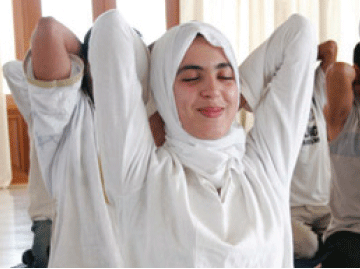
Sudarshan Kriya and Pranayama (SK&P)
The Sudarshan Kriya™ and Pranayama (SK&P) breathing techniques that are taught during the Art of Living Trauma Relief Workshop have numerous physiological benefits. Independent research has found these techniques to:
- Relieve symptoms of post traumatic stress disorder
- Decrease levels of blood lactate, a stress indicator
- Relieve symptoms of depression
- Reduce levels of cortisol, a stress hormone
- Enhance brain function
Effect on Post-Traumatic Stress Disorder
In a study of 180 survivors of the 2004 Southeast Asian Tsunami, practice of SK&P through an eight-hour trauma relief program significantly reduced symptoms of PTSD and depression on psychological tests (PTSD Checklist, Beck Depression Inventory, and Global Health Questionnaire). Improvements occurred in four days and were maintained at three-month and six-month follow-ups.

Trauma Relief Workshop participants practicing Sudarshan Kriya™ breathing technique
Effect on Blood Lactate – A biochemical stress indicator
A study was conducted monitoring stress indicators (superoxide dismutase-SOD, catalase, glutathione, and blood lactate levels) in participants from a Police Training Academy. These participants constitute a highly stressed group who undergo intense physical and emotional training on a daily basis. Those who had practiced SK&P showed statistically significant improvements in all stress indicators in comparison with the control group, including a significant fall in blood lactate levels, suggesting SK&P induces a state of relaxation.
Sharma H, Sen S, Singh A, et al: Sudarshan Kriya practitioners exhibit better antioxidant status and lower blood lactate levels. Biological Psychology. 2003. 63: 281-291.

Decreased Lactate
(An indicator of tension and stress)
Effect on Depression
In a study conducted with patients hospitalized for severe melancholic depression, 68-73% of those practicing SK&P achieved remission, regardless of the severity of their depression (as effective as Imipramine, a common antidepressant). Patients experienced relief from depression within three weeks, even in cases of severe depression, without the side effects caused by ECT or Imipramine.
Janakiramaiah, N., Gangadhar, B.N., Naga Venkatesha Murthy, P.J., et al: Antidepressant effi cacy of Sudarshan Kriya Yoga (SKY) in melancholia: a randomized comparison with Electroconvulsive Therapy (ECT) and Imipramine. Journal of Affective Disorders 2000; 57(1-3):255-9.

Relief from depression, as indicated by
standard psychiatric measures.
Effect on Cortisol – A stress hormone
In a study of hospitalized alcohol dependent patients, those treated with SK&P plus standard treatment had greater reductions in depression, anxiety and cortisol than patients given standard treatment and rehabilitation.
Vedamurthachar A, Janakiramaiah N, Hegde JM, Shetty TK, Subbakrishna DK, Sureshbabu SV, Gangadhar BN: Antidepressant effi cacy and hormonal effects of Sudarshan Kriya Yoga (SKY) in alcohol dependent individuals. Journal of Affective Disorders. 2006 Aug; 94(1-3):249-53.
Enhance Brain Function
To study the effects of SK&P on brain function, EEG (electroencephalogram) changes were recorded in SK&P practitioners, and compared with EEG patterns of doctors and researchers who did not practice SK&P, yoga, or meditation. Significant increases in beta activity were observed as compared to the control group (0.05). These results indicate an increase in focus and heightened awareness in SK&P practitioners. The study also found an increase in EEG alpha activity, with interspersed persistence of beta activity. This indicates a state of relaxation with simultaneous heightened alertness.
Bhatia, M., Kumar, A., Kumar, N., Pandey, R.M., and Kochupillai, V. (2003). Electrophysiologic evaluation of Sudarshan Kriya: an EEG, BAER, and P300 study. Indian Journal of Physiology and Pharmacology, 47, 157-163.


